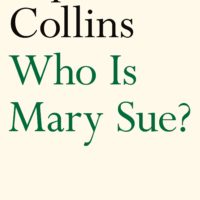I came across Sophie Collins’s Who Is Mary Sue? completely by accident in a local bookshop, but its title instantly grabbed my attention. As a poet who has been writing about and following feminist pop culture for over twenty years, a book titled, defiantly, Who Is Mary Sue?, instantly promises pop-culture awareness and maybe even satire, and the question invokes what is surely a feminist critique of pop culture. The book is a series of prose and poetry collages, all of which seek to answer the question set out in the title.
Coincidentally, I follow a website called The Mary Sue, which calls itself “the premier destination for entertainment geeks, female or otherwise. Coverage includes movies, comics, tv/movie fandom, and other cool stuff.“ The latest “Mary Sue debate” you might have heard about on Twitter was the critique of the new Star Wars character Rey, who was accused by (mainly male) fans of being a “Mary Sue” character—too good at everything, too shallow, too pretty, etc. But see how treacherous the path to Mary Sue-dom might be? Might every character who is female and empowered be termed by male fanboys a “Mary Sue” with some derision? Might every female character, indeed, be a “Mary Sue?” Whether we write about ourselves or others, women authors will always be accused of the sin of autobiography in a way that men typically are not.
On page nineteen of the book, the author, aware that some readers might not be familiar with the term, provides a definition:
Coined by Paula Smith in 1973, “Mary Sue” is a pejorative term used by writers and readers of fan fiction to describe protagonists who are believed to be thinly disguised version of the fan fic’s author’s idealised self.
There is no outright consensus as to Mary Sue’s character type. Invariably, however,
Mary Sue is female;
she is said to be difficult to identify with, poorly constructed, without depth;
she is associated with narcissism and/or wish fulfillment.
See? Tough. How to avoid creating a Mary Sue in your sci-fi adventure, or speculative tale, or Star Wars sequel? Should you even try to avoid it? It’s a question that Collins engages with in a series of poems, prose pieces, quotations, musings of different books and identities, translations, and, at the book’s end, a “Note on Fan Fiction.”
This hybrid book worked more effectively than a tightly wound series of poems might have, because its subjects include the fragmentation of the self as author, the layer of autobiographical narrative in women’s art, and the way the author considers herself as a subject. Who Is Mary Sue? is a hybrid collage book in more ways than one, combining scholarship, poems, quotations, and prose musings in a way that is at once playful and deadly serious, batting around the ideas of female authorhood and critiquing the way the female writers have to at once contain enough autobiography to be considered authentic and worth reading, and to also fend off accusations of “Mary Sue-ism.”
To address the questions of the book, Collins uses such source material as The Story of O, interviews with writers like Lorrie Moore and Sharon Olds, and Joanna Russ’s How to Suppress Women’s Writing. The organization of the book is somewhat challenging, so I’m going to walk you through the sections, which aren’t all that clearly delineated in the book, which I think is purposeful—some sections are surrounded by postscripts and blank pages, others are not; some are clearly titled with section headings, others are not. Seeking to unsettle the reader, Collins is clearly uncomfortable in just one mode, or with just one speaker, or even with organizing things.
In the first section of the book, “Preface,” she begins with a discussion of a novel with a female protagonist who is barely present in the story: “Threadworms, stray hairs: loose threads surround the hole, invading it. They are disturbing: they are unruly, and they emphasised a persistent absence.” She ends the section with a poem in the form of a list called “Eight Phrases:”
– My drink is getting lonely, would you like to join me with yours?
– What’s your name?
– How long does the journey take?
– My father is a policeman.
– I do not have a brother.
– My birthday is January 8th.
– Your breath smells like peaches.
– Can you give me something for the pain?
This intriguing list gives us a peek at the speaker’s identity, but only an opaque peek—we must fill in the blanks. Is the speaker the writer? Is this a list of lines spoken at a bar, or a doctor’s office?
In the next section she provides a definition of the Mary Sue in “Who Is Mary Sue?” and discusses her reactions to anecdotes and quotes by Joanna Russ about the treatment and rejection of women authors. A segment:
Russ again: “If women’s experience is defined as inferior to, less important than, or ‘narrower’ than men’s experience, women’s writing is automatically denigrated… She wrote it but look what she wrote about becomes She wrote it, but it’s unintelligible / badly constructed / thin / spasmodic / uninteresting, etc, a statement by no means identical with She Wrote it, but I can’t understand it (in which case the failure might be with the reader).”
On the following page, a single sentence:
Thus Mary Sue becomes, in my eyes, an unwitting embodiment of the double standard of content.
I won’t lie; this content seems important and timely to me especially in light of #MeToo, in a literary world that mostly ignores the wide swath of women writers who are neither hot twenty-five-year-olds or non-threatening eighty-year-olds (I wrote about this elsewhere on The Rumpus in my essay, “The Amazing Disappearing Woman Writer”). I felt the electricity of this book of poems, collage, and quotes—that it all hangs together in a way that critiques the illusion of wholeness, of the single woman’s voice, or a female narrator, or even the author’s own struggle with the subject matter.
After a blank page, Collins follows up with a series of quotes by women writers taken from interviews—with writers from Lorrie Moore to Jamaica Kincaid to Sharon Olds being asked, basically, about the autobiographical truth of their writing, and their varied (often angry, humorous, and vaguely insulted) responses:
SHARON OLDS // I would use the phrase apparently personal poetry for the kind of poetry that I think people are referring to as “confessional.” Apparently personal because how do we really know? We don’t.
Next come two seemingly autobiographical sections, “The Engine,” a series of first-person prose and poetry describing, among other things, the drama of pregnancy, and “The Engine Continued,” which describes in first-person narrative the experiences of a visual artist being discriminated against during her pregnancy in her art work;
…I get up and notice I am pregnant.; my belly is huge.
I update my social media profiles with the news. The curator stops contacting me. The editors stop contacting me. Only one or two of my peers continue to send me emails…
In the next section, “a whistle in the gloom,” she dissects The Story of O from different theoretical narrators, especially the issue of the narrator’s identity, what the pronoun “O” represents, and the attitudes of the author towards the book and the identity of its main character.
She follows this with a section called “Postface,” containing poetry that has a third-person subject, playfully entitled “The author.” These might be the most autobiographical poems in the book. They begin:
The author receives an email from a press that wishes to publish her first book.
She signs a contract.
She moves countries.
The author has trouble focusing and is always thirsty.
She is experiencing a poor quality of life, emotionally speaking.
She wishes to quit her body.
She follows this with a page of prose called “A Note on Fan Fiction,” which may or may not contain (you decide!) a summary of the entire book, by means of discussing Wide Sargasso Sea, arguably one of the first books of fan fiction.
When reading this book, expect your notions of speaker—and even what a book of poetry is—to be challenged. Who Is Mary Sue? isn’t easy and it doesn’t try to be easy. If you are unafraid of a challenge, Who Is Mary Sue? rewards with thought-provoking juxtapositions and original ways of thinking about an important subject, an electric current that runs through much of contemporary culture: how exactly women are allowed to present their art, and who decides that.
***
Photograph of Sophie Collins © Sam Riviere.





